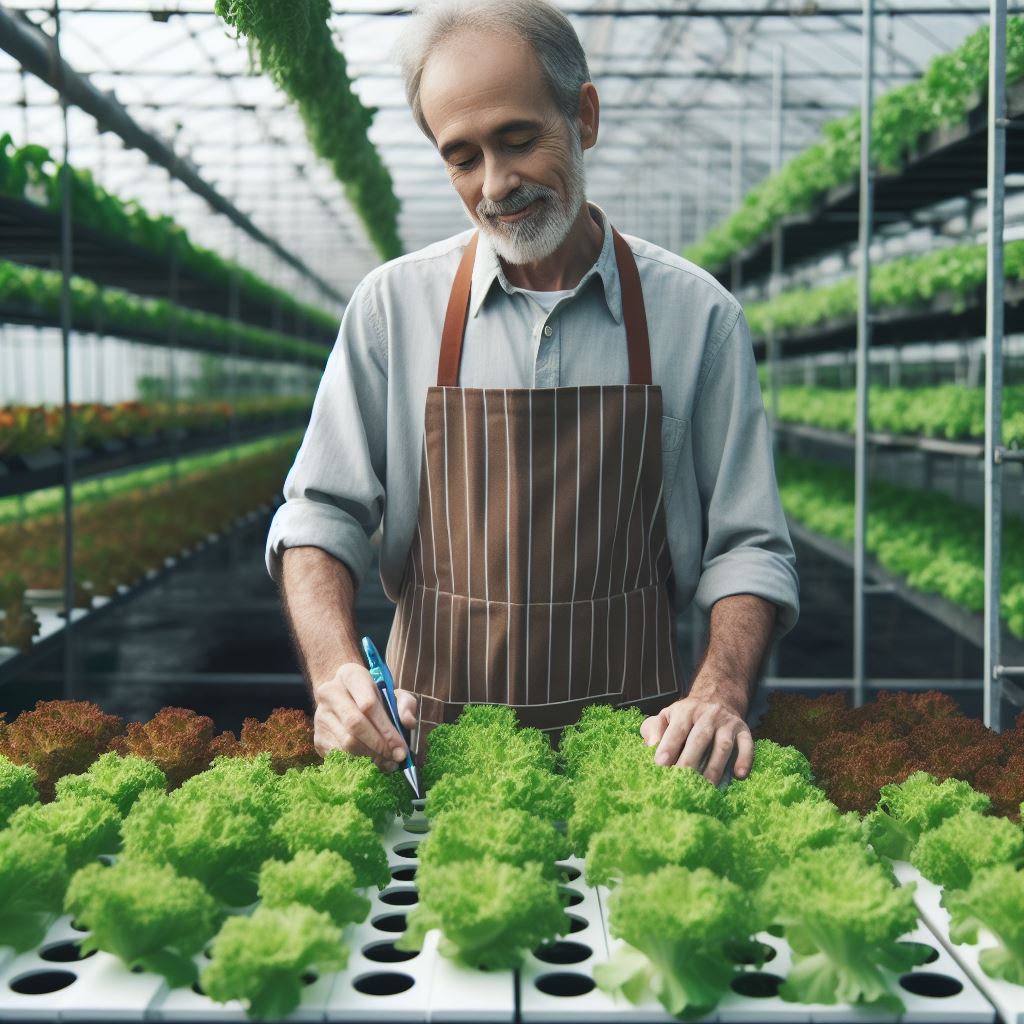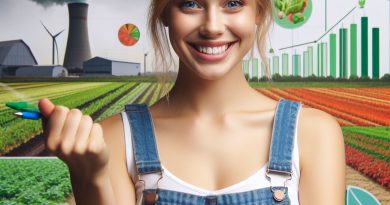Hydroponics: Future of Urban Farming
Last Updated on March 2, 2024
Introduction
Hydroponics, the method of growing plants without soil by using mineral nutrient solutions in water, is the future of urban farming.
With the world’s population increasingly living in cities, finding space to grow food is challenging.
Hydroponics allows efficient food production on small plots, rooftops, or even within buildings.
Unlike traditional farming, hydroponics doesn’t require large land areas, quality soil, or heavy equipment.
Plants grown hydroponically usually yield more, grow faster, and are less prone to disease.
Hydroponics conserves water since the nutrient solutions are recirculated.
The enclosed, controlled systems protect crops from weather and pests.
LED lighting allows year-round production, free from seasons.
Automated systems let hydroponic farms be operated with minimal labor.
For cities, hydroponics means fresh produce can be grown and consumed locally, reducing transport costs, emissions, and food waste.
With numerous environmental and economic benefits, hydroponics is set to transform urban farming and make cities more self-sufficient for food production.
This sustainable farming method can improve food security in urban areas around the world.
Benefits of Hydroponics
- Efficient use of space: Hydroponics allows for vertical farming, maximizing the use of limited urban space.
- Water conservation: Hydroponic systems use up to 90% less water compared to traditional soil-based farming methods.
- Elimination of soil-borne diseases: Since hydroponics doesn’t involve soil, it eliminates the risk of pests and diseases present in traditional farming.
- Increased crop yield: Hydroponics provides optimal growing conditions, resulting in higher crop yields compared to conventional methods.
- More control over plant growth: With hydroponics, farmers have precise control over nutrient levels, pH, and lighting, leading to healthier plants.
- No dependence on weather conditions: Hydroponics allows farming to take place indoors, making it immune to adverse weather conditions.
- Reduced use of pesticides and fertilizers: In hydroponic systems, pests can be controlled without synthetic chemicals, resulting in healthier and safer produce.
- Faster plant growth cycle: By providing plants with an optimal environment, hydroponics enables faster growth, leading to more frequent harvests.
- Year-round farming: Regardless of seasonal changes, hydroponics allows farmers to grow crops all year round, ensuring a consistent food supply.
- Lower transportation costs and carbon footprint: Urban hydroponic farms located in or near cities reduce the need for long-distance transportation, minimizing pollution.
Additional Benefits
- Increased accessibility to fresh produce: With urban hydroponics, fresh and nutritious produce can be grown closer to consumers, reducing the distance traveled from farm to plate.
- Integration with renewable energy sources: Hydroponics can be powered by renewable energy, further reducing its environmental impact and carbon footprint.
- Economic benefits: Hydroponic farming creates employment opportunities in urban areas and boosts local economies.
- Experimental opportunities: Hydroponics allows for experimentation and innovation in plant biology, genetics, and sustainable farming methods.
- Space for vertical gardens: Hydroponics can be used to create beautiful and functional vertical gardens, adding aesthetic value to urban spaces.
- Educational tool: Hydroponic systems serve as educational tools, teaching people about sustainable farming practices and food production.
- Conservation of arable land: By using hydroponics in urban areas, valuable arable land is preserved for other purposes.
- Enhanced food security: Hydroponics mitigates the vulnerability of food production to climate change and other external factors.
- Adaptability to various crops: Hydroponics can be tailored to grow a wide variety of crops, making it versatile in meeting diverse food demands.
- Potential for increased profitability: Hydroponics offers the potential for higher profit margins due to increased yields and reduced production costs.
Essentially, hydroponics provides numerous benefits that make it the future of urban farming.
From efficient space utilization to reduced water consumption, elimination of soil-borne diseases, increased crop yields, and control over plant growth, hydroponics revolutionizes the way we produce food.
Its advantages extend to economic, environmental, and social aspects, making it a sustainable and viable solution for urban areas.
Read: Hydroponics & Aquaponics: Tech Insights
Types of Hydroponic Systems
Nutrient Film Technique (NFT)
Urban farmers widely employ the Nutrient Film Technique (NFT) hydroponic system, utilizing a shallow trough to circulate nutrient-rich water over plant roots continually.
NFT systems are ideal for growing small or light-weight plants such as lettuce, herbs, and strawberries.
This method allows for optimal nutrient absorption and oxygenation of the roots, resulting in faster growth and higher yields.
Deep Water Culture (DWC)
The deep water culture (DWC) hydroponic system is another widely used method in urban farming.
This system involves suspending the plant’s roots in a nutrient-rich solution, allowing them to directly absorb oxygen and nutrients from the water.
DWC systems support thriving growth in larger plants like tomatoes, cucumbers, and peppers.
Containers or net pots nurture plants, while an air pump ensures oxygen, preventing root rot.
Aeroponics
Aeroponics is an advanced hydroponic system that suspends the plant’s roots in the air and misted with nutrient-rich water.
This method allows for maximum oxygen exposure and nutrient absorption, leading to faster growth rates and higher yields.
Aeroponic systems are highly efficient and require less water compared to other hydroponic systems.
They are commonly used to grow a wide range of plants, including herbs, leafy greens, and even orchids.
Drip Irrigation
Drip irrigation hydroponic systems are widely used in commercial and small-scale urban farming.
This system involves delivering nutrients and water directly to the plants’ root zone through a network of tubes and drip emitters.
Drip irrigation systems can be customized to suit various plant types and sizes while maintaining water and nutrient efficiency.
This method is ideal for growing a variety of crops, including vegetables, fruits, and flowering plants.
In conclusion, there are various types of hydroponic systems that are revolutionizing urban farming.
The nutrient film technique (NFT) allows for continuous nutrient circulation, while the deep water culture (DWC) suspends plants in a nutrient-rich solution.
Aeroponics provides optimal oxygen exposure, and drip irrigation ensures efficient water and nutrient delivery.
By utilizing these hydroponic systems, urban farmers can maximize space, reduce water usage, and grow high-quality produce all year round.
These innovative methods pave the way for a sustainable future of urban farming, where fresh and nutritious food is accessible to everyone, regardless of their location or urban environment.
Read: Hydroponic Systems: Tech Advances
Setting up a Hydroponic System
Choosing the right location
- Look for a space that receives adequate sunlight, preferably 6-8 hours a day.
- Ensure the chosen area has easy access to a water source for your hydroponic system.
- Find a location with stable temperature and good ventilation to prevent heat buildup.
Selecting appropriate equipment
- Determine the size and scale of your hydroponic system based on available space and resources.
- Research and choose the type of hydroponic system that best suits your needs – NFT, DWC, or drip system.
- Purchase high-quality equipment such as grow trays, reservoir tanks, air pumps, and pH meters.
Preparing nutrient solution
- Mix the necessary nutrients according to the specific needs of the plants you wish to grow.
- Use high-quality hydroponic nutrients to ensure proper growth and development of your plants.
- Make sure to maintain the correct pH level in your nutrient solution for optimal nutrient uptake.
Seeding and transplanting
- Start by germinating seeds or purchase seedlings from a reliable source.
- Carefully transplant the germinated seeds or seedlings into your hydroponic system.
- Ensure proper spacing and support for the plants to grow and reach their full potential.
Monitoring and maintenance
- Regularly check the pH level and nutrient concentration in your hydroponic system.
- Monitor the water level and keep it at the appropriate level to avoid waterlogging or drying out.
- Inspect for any signs of pests or diseases and take immediate action to prevent their spread.
- Prune and train your plants regularly to promote healthy growth and increase yield.
- Clean and maintain your hydroponic system regularly to prevent the buildup of algae or other contaminants.
Setting up a hydroponic system requires careful planning and attention to detail.
By choosing the right location, selecting appropriate equipment, preparing a nutrient solution, seeding and transplanting, as well as monitoring and maintenance, you can ensure the success of your hydroponic venture.
Enjoy the benefits of urban farming with this innovative and sustainable method, and watch your plants thrive in a controlled and optimized environment.
Read: Hydroponics 101: Basics & Benefits
Hydroponics and Sustainable Urban Farming
Urban farming has gained significant attention in recent years as a solution to various challenges related to food production and sustainability.
One method that stands out as the future of urban farming is hydroponics, which offers numerous benefits to both the environment and urban communities.
Reduction of food miles
One of the key advantages of hydroponics in urban farming is the reduction of food miles, the distance that food travels from farm to consumer.
Traditional farming involves long transportation routes, often resulting in food spoilage and increased carbon emissions.
In hydroponics, crops can be grown directly in urban areas, eliminating the need for long-distance transportation and reducing food waste.
Lower carbon footprint
Hydroponics contributes to a lower carbon footprint compared to conventional farming methods.
Traditional agriculture practices release significant greenhouse gas emissions due to the use of fossil fuel-powered machinery, synthetic fertilizers, and pesticide applications.
In contrast, hydroponics relies on efficient water use, controlled nutrient systems, and natural pest management, resulting in reduced carbon emissions and environmental impact.
Maximizing resource efficiency
Hydroponics offers unparalleled resource efficiency, making it an ideal solution for urban farming.
By growing crops in a soilless system, hydroponics eliminates the need for large land areas, resulting in higher crop yields in limited spaces.
Additionally, the controlled environment allows for optimal use of water and nutrients, minimizing waste and ensuring maximum resource efficiency.
Promoting food security in urban areas
One of the pressing challenges faced by urban areas is food security, which can be addressed through hydroponics.
By growing crops closer to the consumers, urban farming reduces dependence on external food sources and increases access to fresh, nutritious produce.
Furthermore, hydroponics allows year-round cultivation, ensuring a steady food supply irrespective of seasonal variations.
In general, hydroponics presents a sustainable solution for urban farming, providing a range of benefits including the reduction of food miles, lower carbon footprint, maximizing resource efficiency, and promoting food security.
As the world continues to face increasing urbanization and environmental challenges, hydroponics offers a promising pathway towards a more sustainable future.
Read: Hydroponics: Water-Smart Farming Future

Challenges and Limitations of Hydroponics
A successful hydroponic system requires careful consideration of various challenges and limitations that come with this innovative farming technique:
Initial setup costs
- Hydroponics systems have higher initial setup costs compared to traditional soil-based farming methods.
- The cost of purchasing equipment such as grow lights, nutrient solution, and grow beds can be expensive.
- The expenses associated with building and maintaining a controlled environment can also add up.
- However, these costs can be offset by the potential for higher crop yields and reduced water usage in the long run.
Technical knowledge and skills required
- Hydroponics demands a certain level of technical expertise and understanding of plant biology.
- Farmers need to learn about nutrient management, pH balancing, and controlling environmental factors.
- Regular monitoring and adjustments are necessary to ensure optimal growth and prevent crop failure.
- Educating oneself or hiring skilled personnel increases the chances of success in hydroponics farming.
Dependence on electricity
- Hydroponics systems heavily rely on artificial lighting to provide the necessary energy for plant growth.
- This reliance on electricity increases operational costs and raises concerns about environmental sustainability.
- Power outages or electrical disruptions can have a detrimental impact on the entire hydroponic setup.
- Exploring alternative energy sources, such as solar power, can help reduce dependence on the grid.
Limited crop variety
- Some crops are better suited for hydroponics, while others may not thrive in this environment.
- Plants with deep root systems or those requiring extensive support may not be ideal for hydroponics.
- Leafy greens and herbs are commonly grown in hydroponic systems due to their adaptability.
- Expanding the range of crops suitable for hydroponics remains an ongoing challenge.
Waste management
- Hydroponics relies on the continuous recycling of nutrient solutions, which can create waste management challenges.
- Maintaining the balance of nutrients and avoiding nutrient accumulation or deficiency requires careful monitoring.
- Proper disposal of spent nutrient solutions and preventing contamination of water sources is critical.
- Implementing effective recycling and filtration systems can help minimize environmental impact.
Despite these challenges and limitations, hydroponics continues to evolve and present itself as a promising future for urban farming.
Ongoing research and technological advancements are addressing many of these concerns, making hydroponics an increasingly viable and sustainable method of producing fresh, nutritious crops in urban areas.
Success Stories and Examples of Hydroponic Farms
Lufa Farms in Montreal, Canada
Lufa Farms, located in Montreal, Canada, is a prime example of a successful hydroponic farm.
They have revolutionized urban farming by building the world’s first commercial rooftop greenhouse.
Using hydroponic systems, they grow a wide variety of vegetables, such as tomatoes, cucumbers, and peppers, without any soil.
By utilizing the rooftop space, Lufa Farms maximizes their production capability while minimizing their environmental impact.
They have implemented an innovative online platform that connects customers directly with their produce, allowing them to enjoy freshly harvested, high-quality vegetables year-round.
This farm-to-door concept has gained immense popularity and has become a model for sustainable urban agriculture.
Gotham Greens in New York City, USA
Another remarkable hydroponic success story can be found in the heart of New York City, USA.
Gotham Greens has established multiple rooftop greenhouses across the city, growing premium quality herbs, lettuces, and microgreens.
Operating year-round, Gotham Greens utilizes advanced technology, including climate control systems and energy-efficient lighting, to create an ideal environment for plant growth.
Their commitment to sustainable practices is evident, as they use 95% less water and 97% less land compared to traditional farming methods.
Gotham Greens’ produce is delivered to local supermarkets and restaurants within hours of being harvested, ensuring maximum freshness and flavor.
The integration of technology, innovation, and sustainable farming practices has allowed this hydroponic farm to thrive in a bustling urban environment.
Sky Greens Vertical Farm in Singapore
Singapore, known for its limited land resources, is home to the Sky Greens Vertical Farm.
This innovative hydroponic farm tackles the challenge of space constraints by utilizing vertical farming techniques.
The farm features multiple 9-meter tall towers, each housing numerous tiers of vegetable crops.
By rotating these towers, the plants receive optimal exposure to sunlight, ensuring uniform growth.
Additionally, Sky Greens employs an energy-efficient hydraulic system that minimizes water usage.
The produce from Sky Greens Vertical Farm is available in local supermarkets, providing Singaporeans with fresh, locally grown vegetables.
The farm has gained international recognition for its sustainable practices and ability to produce high-quality crops in a limited space.
In essence, hydroponic farms such as Lufa Farms, Gotham Greens, and Sky Greens Vertical Farm have become shining examples of the potential and success of urban farming.
Through their use of advanced technology, innovative techniques, and sustainable practices, these farms have transformed urban spaces into productive havens capable of providing fresh, nutritious produce year-round.
See Related Content: Sustainable Eating: Seminars Near You
Future Developments in Hydroponics
Hydroponics, the future of urban farming, is a rapidly evolving field that holds great potential for sustainable food production.
As technology continues to advance, several exciting future developments can be expected in the realm of hydroponics.
Integration of artificial intelligence
One significant future development in hydroponics is the integration of artificial intelligence (AI).
AI can be used to automate several aspects of hydroponic farming, such as monitoring nutrient levels, adjusting environmental conditions, and optimizing plant growth.
With AI, hydroponic systems can become smarter and more efficient, leading to increased yields and reduced labor requirements.
Use of renewable energy sources
Another important future development in hydroponics is the use of renewable energy sources.
Traditional hydroponic systems often rely on electricity generated from fossil fuels, which contribute to environmental degradation.
By shifting towards renewable energy sources like solar or wind power, hydroponic farms can significantly reduce their carbon footprint and operate more sustainably.
Development of more efficient lighting systems
Lighting plays a crucial role in hydroponics, as plants require specific light spectrums for optimal growth.
Future developments in hydroponics will focus on the development of more efficient lighting systems, such as LED lights.
LED lights are energy-efficient, emit the necessary light spectrums, and can be fine-tuned to suit specific plant requirements.
This enhanced lighting technology will lead to better growth rates and improved crop quality.
Advancements in nutrient solutions and water management
Advancements in nutrient solutions and water management are also expected in the future.
Researchers and hydroponic enthusiasts are continually working on developing more efficient and sustainable nutrient solutions that provide plants with the necessary elements for growth.
We will optimize water management techniques, reducing wastage and promoting responsible resource usage through enhanced recycling and filtration systems.
In a nutshell, the future of hydroponics looks promising, with several exciting developments on the horizon.
Integration of artificial intelligence, use of renewable energy sources, development of more efficient lighting systems, and advancements in nutrient solutions and water management will revolutionize urban farming.
These innovations will not only increase food production but also contribute towards a greener and more sustainable future.
Conclusion
Hydroponics has emerged as a game-changer in urban farming, offering numerous advantages such as water conservation, increased crop yield, and year-round production.
It is essential for individuals and communities to embrace hydroponics to overcome challenges associated with limited space, soil quality, and climate change.
By integrating hydroponic systems into our lives, we can create a sustainable future, reduce our reliance on conventional farming, and ensure food security for generations to come.


